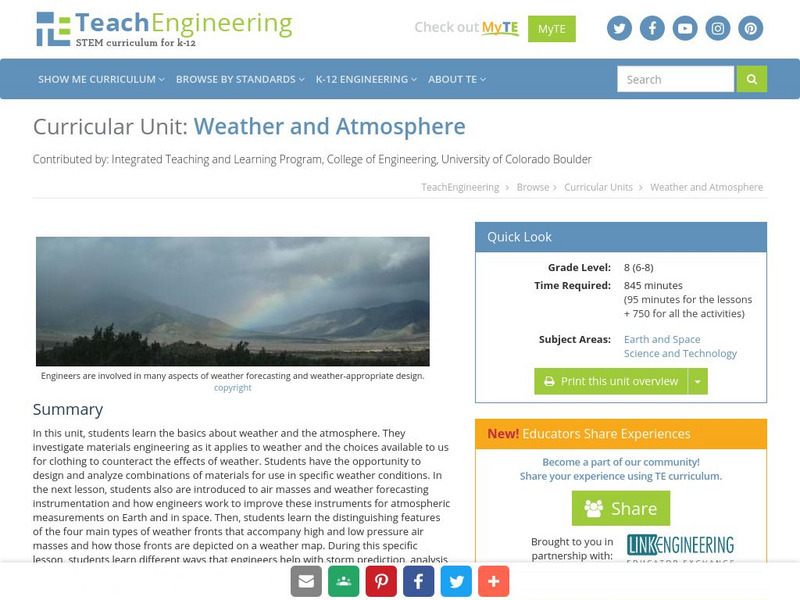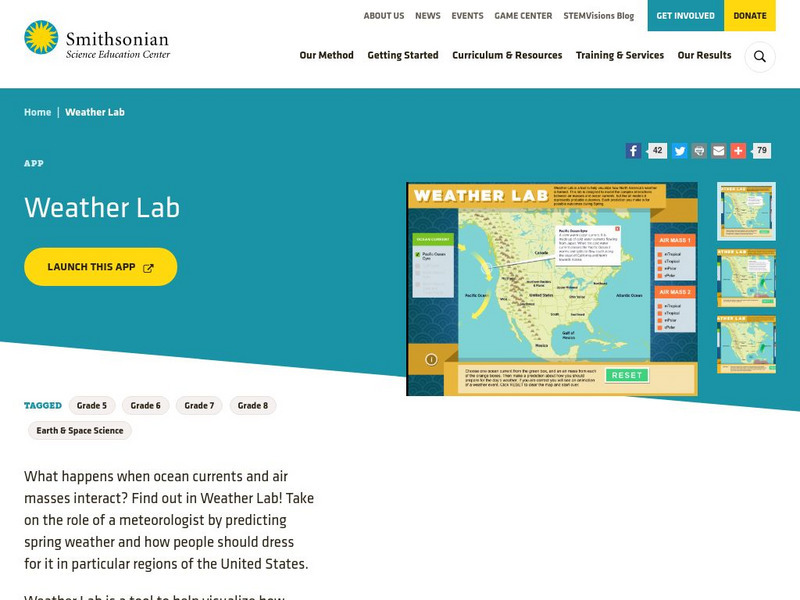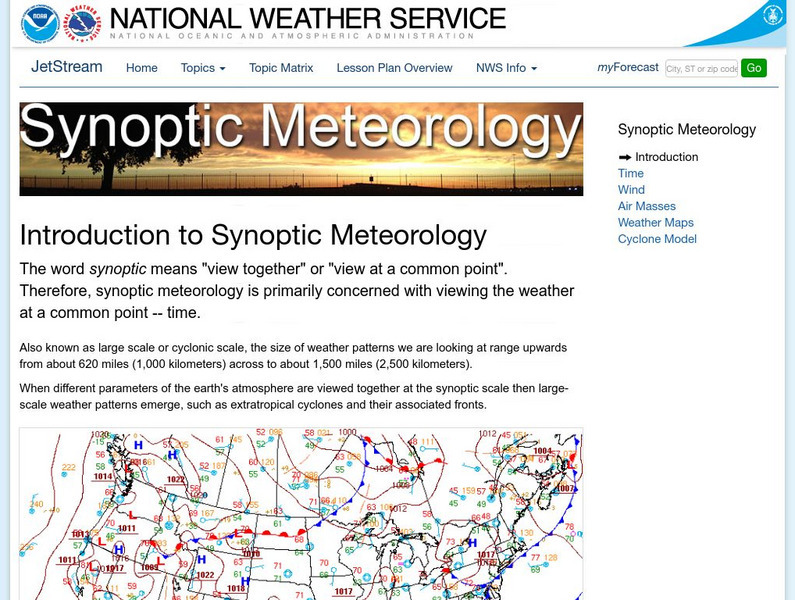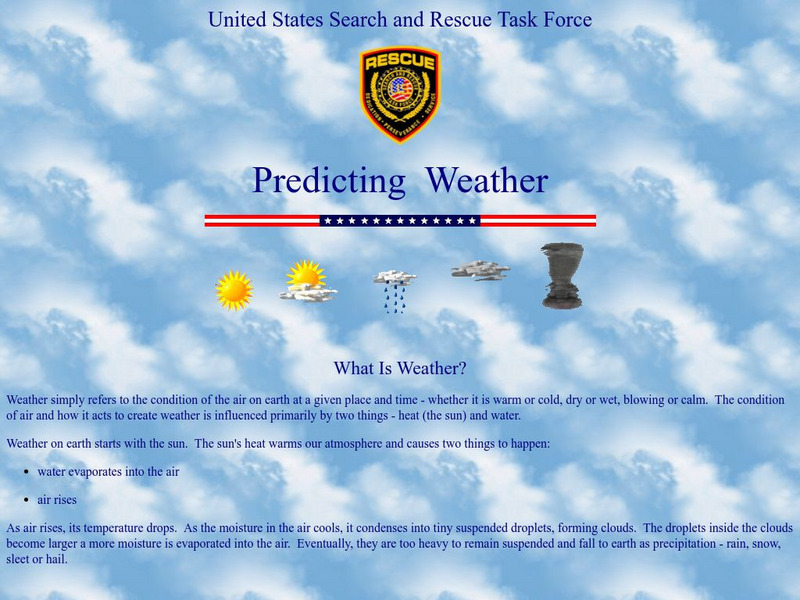Hi, what do you want to do?
Curated OER
Clouds
Second graders explore how to identify cloud types by observing clouds. They record data and have fun by applying newly acquired knowledge throughout the curriculum.
Alabama Learning Exchange
Researching Hurricanes with Technology
High schoolers explain the components that make up a hurricane.
Curated OER
Create Your Own Fog
Students conduct an experiment. In this science instructional activity, students create their own fog. Students observe the results.
Curated OER
It Won't Budge: Balloon
Eighth graders use the scientific method to discover why a balloon is not inflated.
Curated OER
Science Word Search
In this science learning exercise, students look for the words that are related to the theme of the sheet in the word search. They also work on spelling skills.
The Wonder of Science
The Wonder of Science: Ms Ess2 5: Interacting Air Masses and Weather
Work samples, phenomena, assessment templates, and videos that directly address standard MS-ESS2-5: interacting air masses and weather.
University of Illinois
University of Illinois Urbana Champaign: Air Masses and Fronts
What are air masses and where do they originate? What happens to the weather along fronts? Learn about warm and cold fronts and different types of advection. Maps and animated illustrations make these topics easier to comprehend.
TeachEngineering
Teach Engineering: Weather and Atmosphere
In this unit, students learn the basics about weather and the atmosphere. They investigate materials engineering as it applies to weather and the choices available to us for clothing to counteract the effects of weather. Students have...
Scholastic
Scholastic: Study Jams! Science: Weather & Climate: Air Masses & Fronts
A video and a short multiple-choice quiz on the topic of air masses and fronts. It describes the types of weather fronts, what an air mass is, and the four types of air masses in the US.
Texas Education Agency
Texas Gateway: Local Weather
This tutorial investigates how weather is influenced by the jet stream and air masses.
Other
Pete's Potpourri: Numerical Weather Prediction in Faq
This site discusses weather forecast computer modeling, or numerical weather prediction (NWP). It also discusses the development of the concept of front and air masses, as well as which computer forecast models are currently being used...
OpenSciEd
Open Sci Ed: 6.3 Weather, Climate & Water Cycling
Why does a lot of hail, rain, or snow fall at some times and not others? This unit contains four separate lesson plan sets built around answering this question. In the first two lesson plan sets, learners explain small-scale storms. In...
Ministry of Education, Sports & Culture (Samoa) Government
Mesc: Samoa School Net: Forces to Make Weather: Weather & Water Cycle
Explains three forces of nature and how they impact the weather. These include infrared rays from the sun, differences in air pressure, and wind flow when hot and cold air masses meet. Supported by lots of visuals.
TeachEngineering
Teach Engineering: Air Under Pressure
Students are introduced to air masses, with an emphasis on the differences between and characteristics of high - versus low-pressure air systems. Students also hear about weather forecasting instrumentation and how engineers work to...
Smithsonian Institution
Smithsonian Science Education Center: Weather Lab
Find out how good your weather prediction skills are as you study the movements of air and water, and their interactions. Then predict what the spring holds for residents of different regions of the United States, and what people should...
TeachEngineering
Teach Engineering: Backyard Weather Station
In this hands-on activity, students use their senses to describe what the weather is doing and to predict what it might do next. After gaining a basic understanding of weather patterns, students will become state park engineers and build...
PBS
Pbs Learning Media: Mountain Weather
In this interactive activity from NOVA Online you can move an air mass over a mountain and see how several distinct microclimates are created.
ClassFlow
Class Flow: Weather Conditions
[Free Registration/Login Required] This flipchart is a beginning of a unit on weather. The flipchart contains information about fronts, air masses, and wind. There is an assessment quiz at the end.
Other
Physical geography.net: Introduction to the Atmosphere
A very detailed description of air masses, how they move and interact, and what weather takes place when this happens.
National Weather Service
National Weather Service: Jetsream: Synoptic Meteorology
The National Weather Service presents this site on synoptic meteorology, large-scale weather systems. Learn about the structure and behavior of the atmosphere, including clouds, precipitation, winds and more. Also includes learning...
American Geosciences Institute
American Geosciences Institute: Cold Front and Warm Front
Read and understand the differences between a cold and a warm front.
Other
U.s. Search and Rescue Task Force: Predicting Weather
Information on what weather is to begin with, then progresses to how scientists can predict the weather. Common ways to predict weather are also included such as use of a barometer and rain gauge.
University Corporation for Atmospheric Research
Ucar: Weather Images
Photos, diagrams, and other images related to weather.
Other
Kean: Weather Systems [Pdf]
No scientific phenomena concern us as much as the daily evolution of weather systems. We live in a culture where weather, the state of the atmosphere at a given time and place,helps us define regional cultural variations. States such as...






















